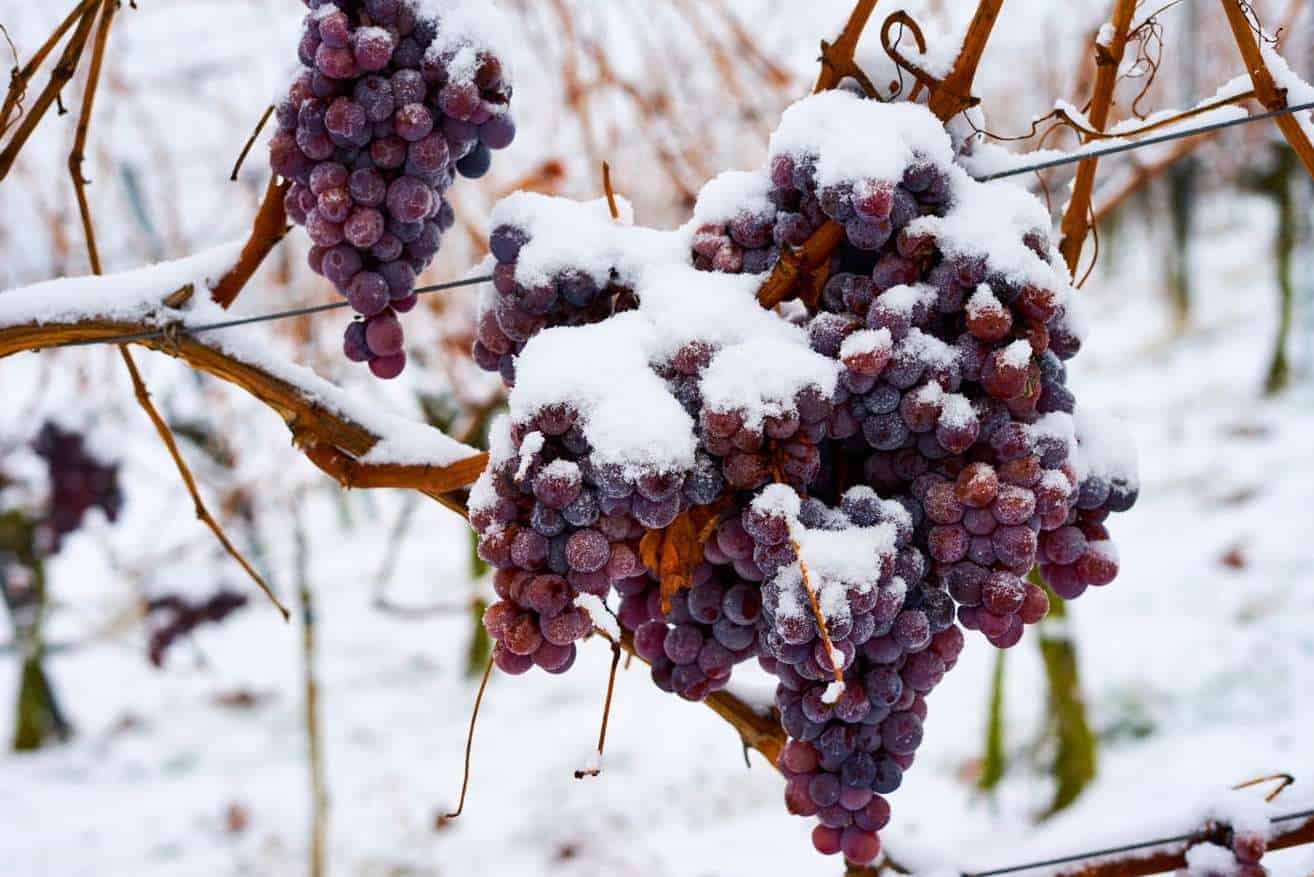Ice wine is another type of wine that is rising in popularity. Its sweet and smooth taste makes it the perfect pairing for many dishes. Want more information? No worries! This article will tell you what ice wine is, its history, and how it’s made.
What is Ice Wine?
| Origin | Germany |
| Commonly made with | Riesling, Vidal |
| Color | Light Pink, White |
| Taste | Sweet |
| Sugar Content (per liter) | 180g to 320g |
| ABV | 7-12% |
| Biggest Producers | Canada, Germany, USA |
Ice wine or Eiswein is a type of sweet white wine. It’s made by freezing the Vitis Vinifera or wine grapes while it’s still on the vine.
With this method, ice wine is mainly present in colder climates. The water solidifies as the grapes freeze while still hanging in the vines, resulting in a more concentrated sugar content.
Due to the difficulty in the process, ice wine is considered a delicacy. One particular bottle of Canadian ice wine was sold for $30,000 in 2006. However, there are mid-range ice wines you could try, some under $100.
Ice wine is famous due to its sweet and smooth taste. As a delicacy, it’s mostly served as a dessert or on its own. Although the ice wine is known for its light pink and white color, the specific winery produces red varieties, such as the Furano region in Japan.
How is Ice Wine Made?
The process of making ice wine is intricate and considers a lot of factors. Most of the time, winemakers use hardy variations of wine grapes such as Riesling and Vidal for ice wine. The vinifera can survive harsh cold climates without being frostbitten or rot.
Since the harvest occurs around December, it’s a tough time to be out in the fields. The wine grapes must be at -10 to -12 degrees Fahrenheit (-20 to -24 degrees Celsius).
The specific temperature makes the harvest and transfer have a small timeframe. It’s also why the harvesting process is mainly done in the middle of the night, making it more challenging for the workers.
Afterward, the grapes should be transferred to the winery to be pressed. This part might be one of the critical parts of the process as the workers must keep the wine grapes at the same temperature as it was on the vine.
Then, the fermentation will start. Compared to table wines which only take a couple of weeks to ferment, ice wines need months to complete. The wine also contains various yeast strains to ensure high-quality ice wine.
Due to the requirements, there are only limited places where ice wine is available. Canada is the prime country in the production of ice wine. However, Northern parts of other countries such as Germany, the USA, and East Asia also has their variations.
History of Ice Wine
Although the first account of the ice wine being made is in 1974 in Germany, there are several accounts of ice wine in the early Roman times around 23 to 79 AD. That said, the first account of the modern ice wine was in Franconia, Germany.
Even though Germany is the first country to produce wine, the primary production is in Canada. In 1972, German immigrant Walter Hainle made the first batch of ice wine in the Okanagan Valley of British Columbia.
Since the 1960s, Canada has been the biggest manufacturer and distributor of ice wine worldwide. Their production is so big that even if you combine all the ice wine in the world, Canada will still come on top.
The country has the prime temperature for freezing wine grapes. It lets the wine grapes freeze but not to the point where they get frostbitten. The ice wine has better quality by having it at a steady prime temperature.
What is the Taste of Ice Wine?
Ice wine belongs to the list of sweet wines. The sweet taste is due to the more concentrated amount of sugar from the grapes. Its sweetness is also why iced wine is mainly served as a dessert.
Although ice wine is a dessert wine, it does not contain Sauternes or Tokaji. As the wine came from Riesling and Vidal, you will have a tinge of citrus flavors rather than a strong sugar taste.
Wineries can sometimes use Chardonnay or Pinot Noir as their primary grapes for ice wine. It can lead to more apricot aftertaste and notes of citrus.
Ice wine is incredibly sweet for two primary reasons: harvest time and reduced water content. Most grapes have a harvest period of September. However, wine grapes for ice wines are harvested during the middle of winter.
The sugar content of the wine can go between 180g and 320 g per liter. Surprisingly, ice wine has a refreshing and light texture despite having a sweeter taste.
Why is Ice Wine so Expensive?
One of the most expensive wines in circulation is the Chardonnay ice wine by Canadian winery Royal DeMaria. In 2006, the winery produced five cases with a $30,000 price tag per half bottle. It’s the most expensive bottle of wine that year, kicking champagne off the first place.
With that said, you might be wondering why ice wines are as expensive as they are. Here are some of the reasons for the higher price tag.
Taxing Labor
Working in a winery that produces iced wine is no joke. The harvesters must pick out the wine grapes in the middle of winter. With the need for a constant temperature, picking happens during the middle of the night or early morning.
The intricate process of the winemakers is not done with the picking. The pressing and fermentation process of the grapes is just as arduous. Due to this harsh condition, the workers need to be compensated fairly.
Precise Temperature
Ice wine is very intricate to make. As stated, workers are often facing various factors when making it. However, most of these challenges hinge on the precise temperature. Since the wine grapes need to be at the same temperature for the pressing, it’s labor extensive to keep them frozen.
Limited Production
Due to the needed climate to produce an ice wine, there is a limited number of places where people can make it organically. It’s mainly in the selected parts of Canada and Northern parts of Germany and East Asia.
Every year, wineries can produce a small number of ice wines due to its labor-intensive process. Since its production is limited, it also means that the number of bottles in the market is fewer compared to standard wine. With its scarcity comes a higher price tag.
How to Drink Ice Wine?
If you are new to drinking ice wine, here are some tips you can keep in mind to elevate your drinking experience.
Pair with More Savory Food
It might surprise you that ice wine can be paired with savory food such as saltine crackers and cheese. If you are into charcuterie boards, most of the components of it, such as saltine crackers and cheese, are a perfect combo with the sweet and tangy taste of the wine.
It might be new, but a particular pungent old cheese, such as blue cheese, can perfectly pair with your ice wine. If you are drinking rice wine in a delicate dining setting, salty hours d’oeuvres is the perfect combo for it.
It’s due to the sweeter taste of the ice wine. The flavors are balanced by pairing them with salty and savory foods.
Cleanse Your Palette
If you want to taste the tangy and unique flavors of ice wine on its own, cleansing your palette every once in a while is the best way to get the unique flavors of ice wine. Try to have a buffer time with every sip. Like other wines, taking a break after every drink can show more taste on your palette.
Ice Wines You Should Try
Are you looking for some ice wines you could try? Well, here is a short list to help with your selection.
1. Inniskillin Vidal Ice Wine: If ice wine is what you are looking for, look no further than Inniskillin. The winery is the top in the Canadian market. It specializes in ice wine and is the leading producer of it. As a starter, this Vidal ice wine is one of their popular selection. It has hints of tropical and acidic flavors. This variety also comes in an oak-aged and sparkling wine version.
2. Dr. Loosen Riesling Eiswein: Dr. Loosen is the winery you want some authentic Eiswein. It’s from Germany, one of the oldest suppliers of Eiswein. Although it’s pricier than other bottles, it’s one of the most popular ice wines on the market. With a hint of tree fruit and citrus flavors, you can ensure a pleasant and smooth taste with this Riesling wine.
3. Marani Satrapezo Icewine: Straight from Georgia, the Marani Satrapezo serves their ice wine with a hundred percent Rkatsiteli. It has strong notes of citrus and orange zest. If you want a one-of-a-kind ice wine, Marani Satrapezo can provide you with unique flavors.
In Summary
We hope this article serves as an informative intro to what is ice wine. Ice wine has many promises as a drink. Its intricate process and delicious taste make it one of the sought-after delicacies in the wine sphere.

George Moore, co-founder of Wine Flavor Guru, is a charismatic entrepreneur with a rich background in California’s wine industry. Alongside Sylvia, he transformed a Sonoma County vineyard into a source of premium wines. George’s expertise in sourcing exceptional grapes and his approachable style make wine appreciation both accessible and engaging.







